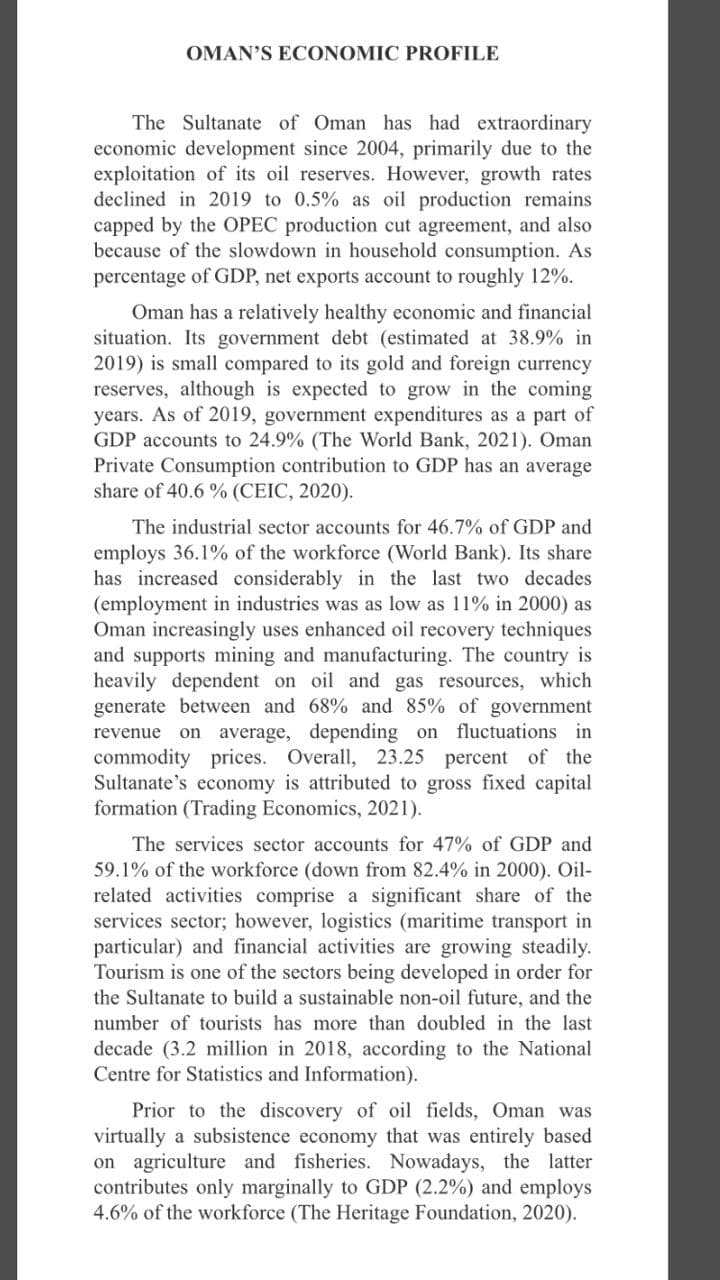Principles of Economics 2e
2nd Edition
ISBN:9781947172364
Author:Steven A. Greenlaw; David Shapiro
Publisher:Steven A. Greenlaw; David Shapiro
Chapter34: Globalization And Protectionism
Section: Chapter Questions
Problem 28RQ: What is dumping? Why does prohibiting it often work better in theory than in practice?
Related questions
Question

Transcribed Image Text:2. Can the Sultanate rely on agriculture to grow its
economy? Justify your answer. (2.5 marks)

Transcribed Image Text:OMAN'S ECONOMIC PROFILE
The Sultanate of Oman has had extraordinary
economic development since 2004, primarily due to the
exploitation of its oil reserves. However, growth rates
declined in 2019 to 0.5% as oil production remains
capped by the OPEC production cut agreement, and also
because of the slowdown in household consumption. As
percentage of GDP, net exports account to roughly 12%.
Oman has a relatively healthy economic and financial
situation. Its government debt (estimated at 38.9% in
2019) is small compared to its gold and foreign currency
reserves, although is expected to grow in the coming
years. As of 2019, government expenditures as a part of
GDP accounts to 24.9% (The World Bank, 2021). Oman
Private Consumption contribution to GDP has an average
share of 40.6 % (CEIC, 2020).
The industrial sector accounts for 46.7% of GDP and
employs 36.1% of the workforce (World Bank). Its share
has increased considerably in the last two decades
(employment in industries was as low as 11% in 2000) as
Oman increasingly uses enhanced oil recovery techniques
and supports mining and manufacturing. The country is
heavily dependent on oil and gas resources, which
generate between and 68% and 85% of government
revenue on average, depending on
commodity prices. Overall, 23.25 percent of the
Sultanate's economy is attributed to gross fixed capital
formation (Trading Economics, 2021).
fluctuations in
The services sector accounts for 47% of GDP and
59.1% of the workforce (down from 82.4% in 2000). Oil-
related activities comprise a significant share of the
services sector; however, logistics (maritime transport in
particular) and financial activities are growing steadily.
Tourism is one of the sectors being developed in order for
the Sultanate to build a sustainable non-oil future, and the
number of tourists has more than doubled in the last
decade (3.2 million in 2018, according to the National
Centre for Statistics and Information).
Prior to the discovery of oil fields, Oman was
virtually a subsistence economy that was entirely based
on agriculture and fisheries. Nowadays, the latter
contributes only marginally to GDP (2.2%) and employs
4.6% of the workforce (The Heritage Foundation, 2020).
Expert Solution
This question has been solved!
Explore an expertly crafted, step-by-step solution for a thorough understanding of key concepts.
Step by step
Solved in 2 steps

Knowledge Booster
Learn more about
Need a deep-dive on the concept behind this application? Look no further. Learn more about this topic, economics and related others by exploring similar questions and additional content below.Recommended textbooks for you

Principles of Economics 2e
Economics
ISBN:
9781947172364
Author:
Steven A. Greenlaw; David Shapiro
Publisher:
OpenStax

Principles of Economics 2e
Economics
ISBN:
9781947172364
Author:
Steven A. Greenlaw; David Shapiro
Publisher:
OpenStax